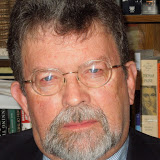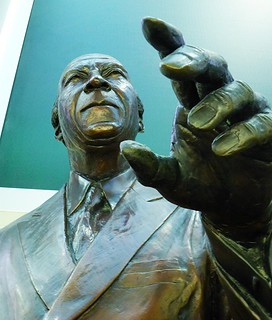A. Philip Randolph by Mike Licht, NotionsCapital.com
Nearly a month ago tens of thousands of Americans publicly celebrated the 50th anniversary of the August 28, 1963, "March on Washington." President Obama addressed the gathering, as did former Presidents Carter and Clinton. Conspicuously absent from the celebration were the leaders of the Republican Party.
The celebration will continue on September 25, 2013, when the 92nd Street Y in New York will host a discussion of the march by four of its participants: Harry Belafonte, John Lewis Clarence Jones and Julian Bond.
A timely book informs this celebration, The March on Washington: Jobs, Freedom, and the Forgotten History of Civil Rights, written by Professor William P. Jones, who teaches history at the University of Wisconsin. Published by W.W. Norton & Company, the book provides the reader with a detailed account of the events that eventually provoked more than 200,000 Americans to march on Washington in August of 1963.
The initial inspiration for the 1963 march was a call, made by union leader A. Philip Randolph in January 1941, for America's Negroes to march on Washington to protest the failure of President Franklin D. Roosevelt to "stop racial discrimination in the armed forces and by defense contractors." (p. 1)
Discrimination in national defense hiring was no small matter, given that F.D.R. already had taken steps to build a great Arsenal of Democracy to help European and Asian allies in their fight against fascism. In the summer of 1940 F.D.R. ordered the U.S. government to spend billions of dollars on the construction of military bases, on the retooling of factories and on the improvement of infrastructure that moved raw materials and finished products. (p.25) Yet, "a survey of employment patterns in twenty defense industries showed that black workers got only 5.4 percent of the jobs created that year and that this figure fell to only 2.5 percent a year later." (p. 26)
Initially, F.D.R. dismissed the prospect of a march, even after Mr. Randolph threatened to bring "ten to fifty thousand negroes" to the city. But, as the July 1, 1941, date for the march drew nearer, F.D.R's "White House went into a panic." (p. 38).
Thus, on June 25, 1941, Roosevelt issued an executive order largely aimed at reducing racial discrimination in the defense industry through the institution of a Fair Employment Practices Committee (FEPC), chaired by five officials appointed by the President. (pp. 38-39) It was enough to persuade Randolph to cancel the march.
Nevertheless, "by the summer of 1942, it was clear that Roosevelt's executive order was being implemented only in places where black activists could force local officials into addressing discrimination." (p.50)
Worse, an FEPC investigation of hiring and promotion practices at the Alabama Dry Dock and Shipbuilding Company in Mobile led to a riot by thousands of men and women on May 24, 1943 after the company agreed to upgrade twelve black men into skilled welding jobs. (p. 63) A week later, in Detroit, "25,000 white workers walked out of the Packard Motor Car Company because three black workers had been upgraded into skilled positions-- (p.66)
According to Professor Jones, the riots effectively killed Mr. Randolph's March on Washington Movement and forced him to create a new grass roots organization devoted to establishing a permanent FEPC. However, when conservatives in Congress filibustered and then killed the bill calling for a permanent FEPC, Randolph reorganized yet again while attaching himself to what eventually became the Leadership Council on Civil Rights.
The driving force behind the Leadership Council on Civil Rights was Roy Wilkins, head of the NAACP. Like the NAACP, the Council focused on elite leadership, lobbying and litigation rather than grassroots activity and protest.
"Wilkin's approach won a stunning victory on May 17, 1954, when the Supreme Court accepted the NAACP's argument in the case of Brown v. Board of Education and ruled that segregation of public schools was, in fact, unconstitutional." (p.81) But a subsequent court ruling that allowed the states "all deliberate speed" in implementing desegregation "set the stage for a series of confrontations between supporters and opponents of Jim Crow in communities across the South." (Ibid)
The racists responded to the Brown decision by forming ignoble Citizens' Councils, which pressured "local businessmen to deny jobs and credit to anyone -- black or white -- who dared to criticize segregation." (p.87) Racists also passed laws or used court injunctions to ban the NAACP from operating in the South. "Ironically," notes Professor Jones, "the backlash against the NAACP facilitated the emergence of grassroots movements that would ultimately succeed in implementing the Brown decision." (p.82)
Many of those grassroots movements were inspired by the non-violent movement in Montgomery, Alabama, which organized a successful and historic boycott of the city's buses in late 1955, after Rosa Parks was arrested for refusing to vacate her seat for a white person.
The success of the one-day bus boycott led to its continuation, which provoked terrorist bomb attacks by white racists and the subsequent arrest of the non-violent movement's leader, Dr. Martin Luther King, Jr. Both provocations became front-page news across the nation and the world.
After the Supreme Court ordered the integration of Montgomery's buses, ugly (and presumably "Christian") southern white folk responded with shotgun blasts, bomb blasts and sniper fire, as well as the arrest of 21 protesters as they attempted to desegregate the city's buses. In response, 100 black ministers, educators, labor leaders, and business owners met at a "Southern Leadership Conference on Transportation and Nonviolent Integration," led by Dr. King and held at his father's church in Atlanta on January 10, 1957. Subsequently renamed the Southern Christian Leadership Conference (SCLC), it worked "to strengthen ties among the various local movements that had developed in the South during the previous year." (p 112)
(Note: You can view every article as one long page if you sign up as an Advocate Member, or higher).






